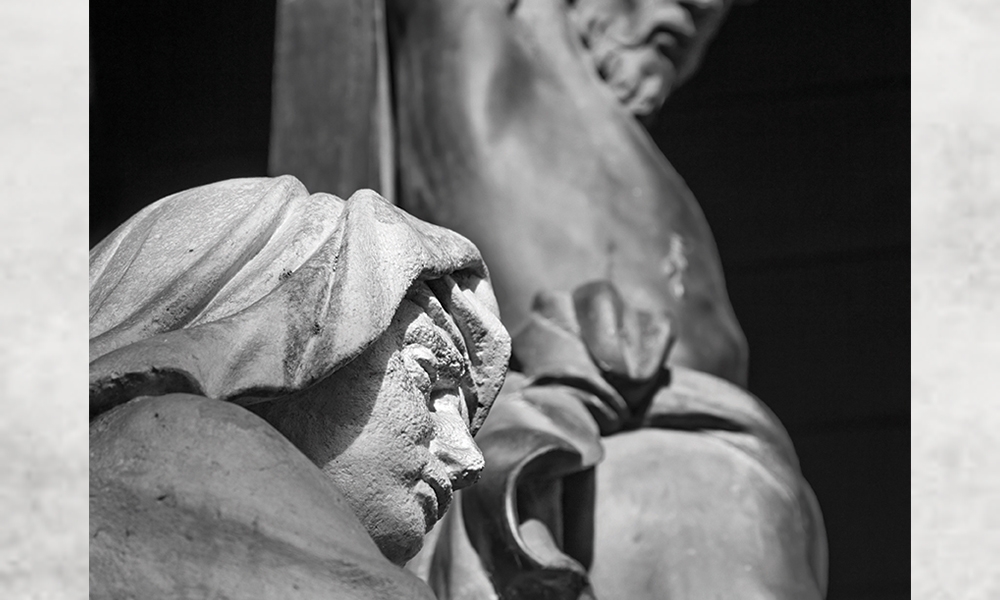
A just end?
Getting your Trinity Audio player ready...As we celebrate the Feast of Our Lady of Sorrows this month, we think of Mary standing under the cross — actually under three crosses for three very different men condemned to death. One was Mary’s Son, the Innocent One and the Son of God. All three were condemned by public authority to death. This article will give a brief history of the Church’s understanding of the death penalty.
As we celebrate the Feast of Our Lady of Sorrows this month, we think of Mary standing under the cross — actually under three crosses for three very different men condemned to death. One was Mary’s Son, the Innocent One and the Son of God. All three were condemned by public authority to death. This article will give a brief history of the Church’s understanding of the death penalty.
St. Paul in the Letter to the Romans was quite direct:
“Let every person be subject to the governing authorities. For there is no authority except from God, and those that exist have been instituted by God…. If you do wrong, be afraid, for he does not bear the sword in vain; he is the servant of God to execute his wrath on the wrongdoer.” (Rom 13:1, 4).
Pope Innocent III, in 1210, added the caveat: provided the penalty proceeds “not from hatred but with judgment, not carelessly but with due solicitude.” Within that same century, St. Thomas Aquinas taught that if a man is dangerous to the community, it is advantageous that he be killed “to safeguard the common good” (II-II, Q 64, a2). Three centuries later, the Catechism of Trent affirmed that rather than being considered the crime of murder, capital punishment is “an act of paramount obedience to this commandment which prohibits murder.” Ideally, when the punishment is accepted by the guilty party, repentance and conversion is possible. Towards the end of the 16th century, St. Robert Bellarmine considered that if the offender converted, the execution could be considered an expiation and a “good” death. Even in the 20th century, the Church considered the death sentence to be efficacious, especially to those not restrained by any other penalty. Moreover, Leo XIII (1901) and Pius XII (1952) said that by committing a serious crime the perpetrator “has already dispossessed himself of his right to live.” The prime reasons for the death penalty throughout these centuries were:
Restoration of order and justice, for a crime against an individual is a crime against humanity, as God told Cain: “your brother’s blood is crying out to me from the ground!”
- Protection of the common good of society
- Conversion and salvation of the criminal
In more recent times, the Church has shifted her emphasis considerably on the application of these principles in the light of modern conditions. In 1969, Pope St. Paul VI removed the use of the death penalty from the “fundamental law” of Vatican City. Pope St. John Paul II, in his encyclical, Evangelium Vitae (“The Gospel of Life”), clarified that there is the possibility for modern society to have “the means of effectively suppressing crime by rendering criminals harmless without definitively denying them the chance to reform.” (56) He authorized a revision to the Catechism of the Catholic Church: The use of capital punishment could only be in “cases of absolute necessity” which are “very rare, if not practically non-existent.” St. John Paul II also modified the Catechism to explain that “the guilty party’s identity and responsibility” must be fully determined. (Since 1973, 200 people on death row have been exonerated.) In 2018 Pope Francis amended the Catechism (2267) to state: “the death penalty is inadmissible because it is an attack on the inviolability and dignity of the person” and “more effective systems of detention have been developed, which ensure the due protection of citizens but, at the same time, do not definitively deprive the guilty of the possibility of redemption.”
This brief historical elaboration of the Church’s understanding of the death penalty indicates a shift in emphasis on the way to achieving the goals of a restoration of order, the protection of the common good, and the redemption of the criminal. Civil society in the 21 century can provide centers of life-imprisonment and rehabilitation of an offender far more effectively than ever before in history, and perhaps surprisingly at less expense to the public.
Therefore, recent Holy Fathers have emphasized that, while the death penalty is not in itself an intrinsic evil, as is abortion, in modern times the requirements of justice can be met without necessitating capital punishment. Moreover, one wonders about cultural shifts that have obscured the meaning of terms that used to be taken for granted: “justice,” “natural law,” and even “life.” The good thief on the cross acknowledged that he had done wrong and was receiving a just punishment. But if human life is no longer valued in society, how can a violent criminal be expected to acknowledge his guilt? If truth is always relative, how is justice applied? These are questions we need to grapple with in relation to crime and punishment.
The teaching of the Catechism regarding the death penalty is authoritative teaching, but it is non-definitive (non-infallible). Let us prayerfully strive to understand the counsel of the recent Holy Fathers. Of course, this requires faith, as it did of Mary standing under the Cross.



